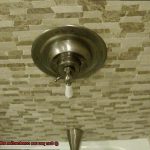Today, we’re tackling a question that has puzzled many: Can you put brass and aluminum together? Well, buckle up because the answer is a resounding YES. But hold on tight, because there are some things you need to know about this dynamic duo before diving headfirst into your next project.
Brass, with its tough-as-nails durability and eye-catching golden shine, has been stealing hearts for centuries. And then there’s aluminum, the lightweight superstar that boasts unrivaled resistance against those pesky corrosion monsters. When these two metals join forces, it’s like a cosmic explosion of properties that can open up a world of possibilities for all sorts of cool applications.
In this blog post, we’re going to spill the beans on all the perks of combining brass and aluminum. We’re talking increased strength without sacrificing weight, baby. But hey, it’s not all sunshine and rainbows – there are some downsides too. We’ll be real with you about potential issues like galvanic corrosion (ugh.) and those pesky thermal expansion coefficients that just can’t seem to agree.
By sharing this juicy info with you, we want to arm you with the knowledge to make smart choices when it comes to mixing brass and aluminum in your projects. Whether you’re a DIY enthusiast looking for your next adventure or a metalworker seeking inspiration, get ready to embark on an epic journey through the wild world of brass-aluminum combos.
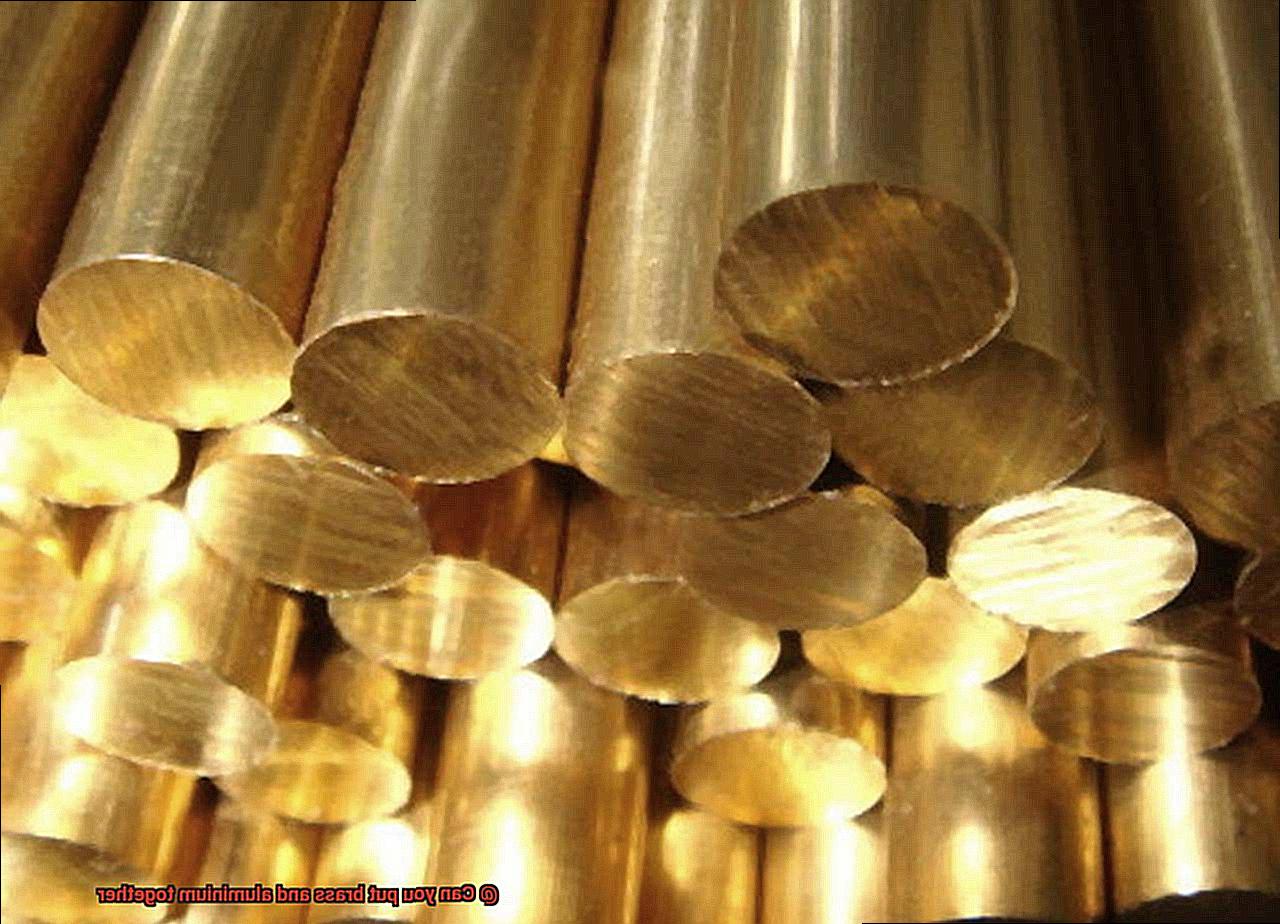
So grab your safety goggles and strap yourself in – it’s time to explore the advantages and disadvantages of putting brass and aluminum together. Let’s dive into this captivating realm where two metals unite as one.
What are Brass and Aluminum?
Contents
- 1 What are Brass and Aluminum?
- 2 The Differences between Brass and Aluminum
- 3 Galvanic Corrosion between Brass and Aluminum
- 4 Isolating Brass and Aluminum to Prevent Corrosion
- 5 Adhesives for Joining Dissimilar Metals
- 6 Choosing the Right Adhesive for Joining Brass and Aluminum
- 7 Limitations of Bonding Brass and Aluminum
- 8 Alternative Methods of Joining Brass and Aluminum
- 9 Conclusion
Brass and aluminum, two extraordinary metals, have carved out prominent roles in various industries and applications. From their captivating appearances to their exceptional properties, these metals offer a wide range of possibilities. In this article, we will explore the characteristics of brass and aluminum, unraveling what sets them apart and how they can be effectively employed.
Brass: The Golden Ally
Brass, a captivating alloy of copper and zinc, boasts a distinctive yellowish hue that adds a touch of elegance to any setting. Its composition can vary, resulting in a spectrum of colors ranging from warm reds to rich browns. Yet, brass is not solely about aesthetics; it is celebrated for its exceptional strength, corrosion resistance, and malleability. This versatility has made it a go-to material for musical instruments, plumbing fittings, decorative items, electrical connectors, and countless other applications.
Aluminum: The Lightweight Champion
In the realm of metals, aluminum stands tall as a true lightweight champion. With its silvery-white appearance, it infuses a sense of modernity wherever it is utilized. However, its appeal transcends mere looks; aluminum possesses remarkable properties such as low density, excellent corrosion resistance, durability, and high thermal conductivity. These qualities make it an ideal choice for construction projects, transportation systems, packaging solutions, electrical wiring installations, and countless other applications.
Differences in Properties:
- Density: Brass exhibits a higher density compared to aluminum. While brass typically weighs between 8.4 to 8.7 grams per cubic centimeter (g/cm³), aluminum is significantly lighter at approximately 2.7 g/cm³. This discrepancy in density makes brass heavier than aluminum.
- Conductivity: Both metals exhibit electrical conductivity; however, brass outshines aluminum in this aspect. The superior conductivity of brass makes it an ideal material for electrical connectors and terminals where efficient conductivity is paramount.
- Corrosion Resistance: Brass surpasses aluminum in terms of corrosion resistance. The presence of copper in brass imparts excellent corrosion-resistant properties, enabling it to withstand harsh environments and moisture exposure. While aluminum is naturally resistant to corrosion, it can be susceptible to specific types of corrosion, particularly in corrosive environments or when in contact with certain chemicals.
Joining Brass and Aluminum:
When considering the combination of brass and aluminum, precautions must be taken due to the risk of galvanic corrosion. Galvanic corrosion occurs when two dissimilar metals come into contact with each other in the presence of an electrolyte such as moisture. To prevent this, methods such as using insulating materials, applying coatings, or employing mechanical fasteners that separate the metals can be implemented. Additionally, special adhesives designed for bonding dissimilar metals can be utilized, but careful consideration of application conditions is necessary.
The Differences between Brass and Aluminum
Brass and aluminum, although both metals, possess distinct properties and characteristics that set them apart from each other. Let’s delve into the key disparities between these two materials.
Composition:
- Brass, an alloy formed primarily from copper and zinc, exhibits a unique yellowish-gold color that is visually captivating.
- Aluminum, on the other hand, is a pure metal extracted from bauxite ore, boasting a sleek and modern silver-white appearance.
Appearance:
- The golden hue of brass adds an aesthetic appeal, often making it the material of choice for decorative items.
- Aluminum’s silver-white appearance gives it a clean and contemporary look, rendering it suitable for various modern applications.
Strength:
- Brass is renowned for its superior strength and durability, capable of withstanding heavy loads. It finds common usage in applications such as musical instruments and plumbing fittings.
- Although lightweight, aluminum still possesses commendable strength. This attribute makes it extensively used in industries such as aerospace, automotive, and construction.
Malleability:

- Brass showcases remarkable malleability and ductility, allowing it to be effortlessly shaped into intricate designs.
- While aluminum also exhibits some malleability, it falls short of the exceptional pliability offered by brass.
Conductivity:
Antimicrobial Properties:
- Brass possesses antimicrobial properties that make it inherently resistant to bacterial growth. This characteristic proves advantageous in applications where hygiene is paramount, such as medical equipment or kitchen utensils.
- Aluminum does not possess similar antimicrobial qualities.
Cost:
In terms of cost, brass generally surpasses aluminum in expense. This discrepancy arises from the composition and manufacturing process involved in producing brass.
Galvanic Corrosion between Brass and Aluminum
Brass and aluminum – a seemingly perfect combination of strength and beauty. However, when these two metals meet, a silent battle ensues – the dance of galvanic corrosion. In this blog post, we will delve into the process of galvanic corrosion between brass and aluminum, uncover the reasons behind its occurrence, and explore effective preventive measures.
The Battle Begins: Galvanic Corrosion Explained:
Galvanic corrosion occurs when dissimilar metals come into contact in the presence of an electrolyte. Brass and aluminum, with their contrasting electrochemical properties, set the stage for this corrosive tango. Brass, an alloy of copper and zinc, assumes the cathode role, while aluminum becomes the anode.
The Electrochemical Tango:
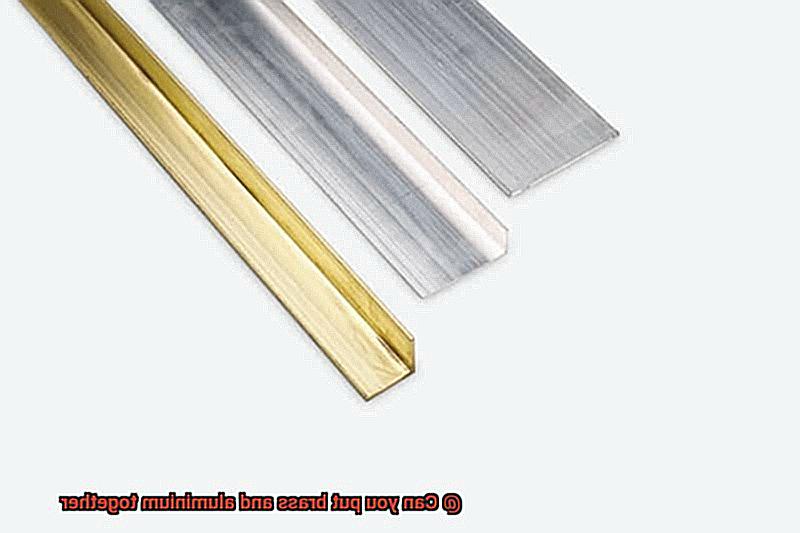
As the dance commences, electrons flow from the anode (aluminum) to the cathode (brass), initiating an electrochemical reaction. This reaction results in a faster corrosion rate for the anode (aluminum) compared to the cathode (brass). Moisture or other electrolytes further amplify this dance, creating a conducive environment for galvanic corrosion to thrive.
Preventing the Dance of Destruction:
To shield our metals from this corrosive tango, preventive measures are essential. Let us explore two effective techniques:
Barrier Materials:
By physically separating brass from aluminum, we can significantly reduce the likelihood of galvanic corrosion. Non-conductive coatings like paint or insulating materials act as barriers, preventing direct contact between the metals. This separation ensures that they dance alone without causing harm to each other.
Cathodic Protection:
This technique involves introducing a sacrificial anode made of a more active metal like zinc or magnesium. By connecting it to the aluminum component, the sacrificial anode attracts the corrosion process towards itself, sacrificing its own metal instead of allowing the aluminum to corrode. Periodic replacement of the sacrificial anode is necessary, but this method effectively safeguards the aluminum from galvanic corrosion.
The Final Curtain Call:
Before we conclude, let us remember that not all combinations of brass and aluminum result in galvanic corrosion. Factors such as alloy composition, surface conditions, and the presence of electrolytes play a significant role. Therefore, careful consideration is crucial when deciding to combine brass and aluminum in a specific application.
Understanding the dance of galvanic corrosion between brass and aluminum empowers us to take preventive measures. By using barrier materials or employing cathodic protection techniques, we can ensure that these two metals coexist peacefully without succumbing to the destructive forces of galvanic corrosion.
Isolating Brass and Aluminum to Prevent Corrosion
In the realm of metals, brass and aluminum are formidable players. However, when these two meet, their encounter can unleash a corrosive chemical reaction known as galvanic corrosion. This destructive dance can swiftly erode these metals, compromising their strength and durability. Yet, fear not. By employing various isolation techniques, we can fortify brass and aluminum against corrosion’s relentless assault, ensuring their endurance and longevity.
Understanding Galvanic Corrosion:
Picture this: dissimilar metals, like brass and aluminum, joined together in the company of an electrolyte, such as moisture or saltwater. In this captivating tale, aluminum bravely assumes the role of the anode, surrendering itself to protect the noble cathodic brass. As electrons exchange hands, aluminum succumbs to pitting, cracking, and ultimately succumbing to failure.
Methods of Isolation:
To halt the destructive waltz of galvanic corrosion between brass and aluminum, we must erect a barrier between them. One effective stratagem entails adorning both surfaces with a non-conductive coating like paint or lacquer. This artistic layer forms an insulating shield, severing direct contact and thwarting the electrochemical assault.
Another valiant option involves interposing gaskets crafted from resilient plastic or rubber between these metal comrades. These plucky materials forge a physical divide that repels any potential electrical currents from traversing their path. Furthermore, selecting fasteners forged from compatible materials—such as stainless steel or nylon—bolsters the isolation endeavor.
Benefits of Isolation:
The art of isolating brass and aluminum bears plentiful rewards. Primarily, it safeguards the essence of both metals, fending off galvanic corrosion’s malevolent advances while preserving their functionality and endurance. Secondly, it obviates the need for costly replacements or repairs triggered by corrosion-induced damage. Moreover, isolating these metals nurtures diligent maintenance practices, as vigilant inspections can swiftly detect signs of wear or decay.
Adhesives for Joining Dissimilar Metals
The secret lies in selecting the perfect adhesive for the task at hand. In this comprehensive guide, we will delve into the key factors to consider when choosing an adhesive to bond these two metals together. From the renowned epoxy resin to the rapid bonding capabilities of cyanoacrylate glue, we will explore an array of adhesive options and provide invaluable tips for achieving flawless bonding results.
Factors to Consider:
Material Compatibility:
Brass and aluminum possess distinct physical properties and chemical compositions. Thus, it is crucial to opt for an adhesive specifically engineered for bonding dissimilar metals. Among the top choices, epoxy resin reigns supreme due to its exceptional strength and durability.
Surface Preparation:
Achieving a robust bond requires meticulous surface preparation. Thoroughly cleanse both brass and aluminum surfaces, eliminating any traces of grease, oil, or oxide layers. Employ solvents or metal cleaners for this purpose, while roughening the surfaces with sandpaper or a wire brush enhances adhesion potential.
Thermal Expansion Coefficients:
The thermal expansion coefficients of brass and aluminum must not be overlooked when selecting an adhesive. Opting for an adhesive with a comparable coefficient of thermal expansion reduces the risk of bond failure caused by thermal stress.
Adhesive Options:
Epoxy Resin:
Unparalleled in terms of bonding strength and durability, epoxy adhesives are ideal for joining dissimilar metals. Seek out epoxy adhesives specifically formulated for bonding brass and aluminum for optimal results.
Cyanoacrylate Glue:
Renowned as super glue, cyanoacrylate glue boasts rapid bonding capabilities and exceptional strength. Prioritize thorough cleaning and preparation of surfaces before applying this adhesive to achieve optimum outcomes.
Specialized Adhesives:
The market also offers specialized adhesives meticulously crafted for bonding dissimilar metals. These adhesives are designed to overcome the challenges posed by the distinctive properties of brass and aluminum, ensuring steadfast bonds.
Choosing the Right Adhesive for Joining Brass and Aluminum
With numerous options available, it can be overwhelming to make the right choice. Fear not. This comprehensive guide will explore key considerations in adhesive selection, ensuring your projects stand the test of time.
Compatibility:
First and foremost, consider the adhesive’s compatibility with both brass and aluminum. Look for adhesives known to effectively adhere to these materials. Epoxy, cyanoacrylate (super glue), and polyurethane-based adhesives are renowned for their compatibility with brass and aluminum. They offer excellent bonding properties, guaranteeing strong and reliable joints.
Strength Matters:
Due to the relatively soft nature of brass and aluminum, it’s crucial to select an adhesive that provides sufficient strength to hold the joint together. Epoxy adhesives excel in this regard, offering high strength and durability. They can withstand a wide range of temperatures, making them suitable for various environments.
Temperature Resistance:
To ensure long-lasting bonds, opt for an adhesive capable of withstanding temperature changes without compromising its bonding properties. Brass and aluminum expand and contract at different rates when exposed to heat. Polyurethane-based adhesives are known for their resistance to temperature changes, making them a reliable choice.
Corrosion Resistance:
Both brass and aluminum are prone to corrosion over time. Combat this issue by selecting an adhesive resistant to corrosion. Epoxy, cyanoacrylate, and polyurethane-based adhesives all offer good corrosion resistance. This preserves the joint’s integrity and ensures its longevity.
Surface Preparation:
Before applying any adhesive, thoroughly clean the surfaces of both brass and aluminum. Dirt, grease, or oxidation can interfere with the bonding process. Use a solvent or sandpaper to clean the surfaces effectively. Additionally, slightly roughening the surfaces with sandpaper or a wire brush increases the bonding surface area and enhances the adhesive’s grip.
Follow Instructions:
For optimal results, always follow the adhesive manufacturer’s instructions. Each adhesive may have specific application methods and curing times. By carefully following these instructions, you can ensure a bond that is as strong as possible.
Limitations of Bonding Brass and Aluminum
Bonding brass and aluminum can be a formidable task due to the stark contrast in their physical properties. However, with a comprehensive understanding of their limitations and strategic approaches, it is possible to establish a robust and enduring bond between these materials. In this expert guide, we will explore the limitations of bonding brass and aluminum and discuss effective strategies to overcome them.
Melting Point Mismatch:
- Traditional welding techniques fall short due to the divergent melting points of brass and aluminum.
- Alternative methods such as soldering or brazing are better suited for bonding these dissimilar metals.
- Reliable results can be achieved using low-temperature brazing alloys or specialized adhesives designed for dissimilar metal bonding.
Differential Thermal Expansion:
- Brass and aluminum exhibit distinct thermal expansion coefficients.
- This incongruity in expansion rates can induce stress and jeopardize the integrity of the bond.
- Prioritizing adhesives with exceptional flexibility and incorporating thermal breaks or buffers can effectively mitigate stress-related issues.
Electrical Compatibility:
- Brass and aluminum possess divergent electrical conductivity properties.
- Vigilant consideration is necessary to avoid galvanic corrosion or subpar electrical connections.
- Opt for adhesives or bonding methods that minimize electrical resistance while ensuring a stable bond.
Mechanical Property Mismatch:
- The relatively soft nature of brass compared to the strength of aluminum affects the bond’s overall durability.
- Enhance the bond by utilizing adhesives with high shear strength or consider supplementing adhesive bonding with mechanical fastening methods.
Surface Preparation:
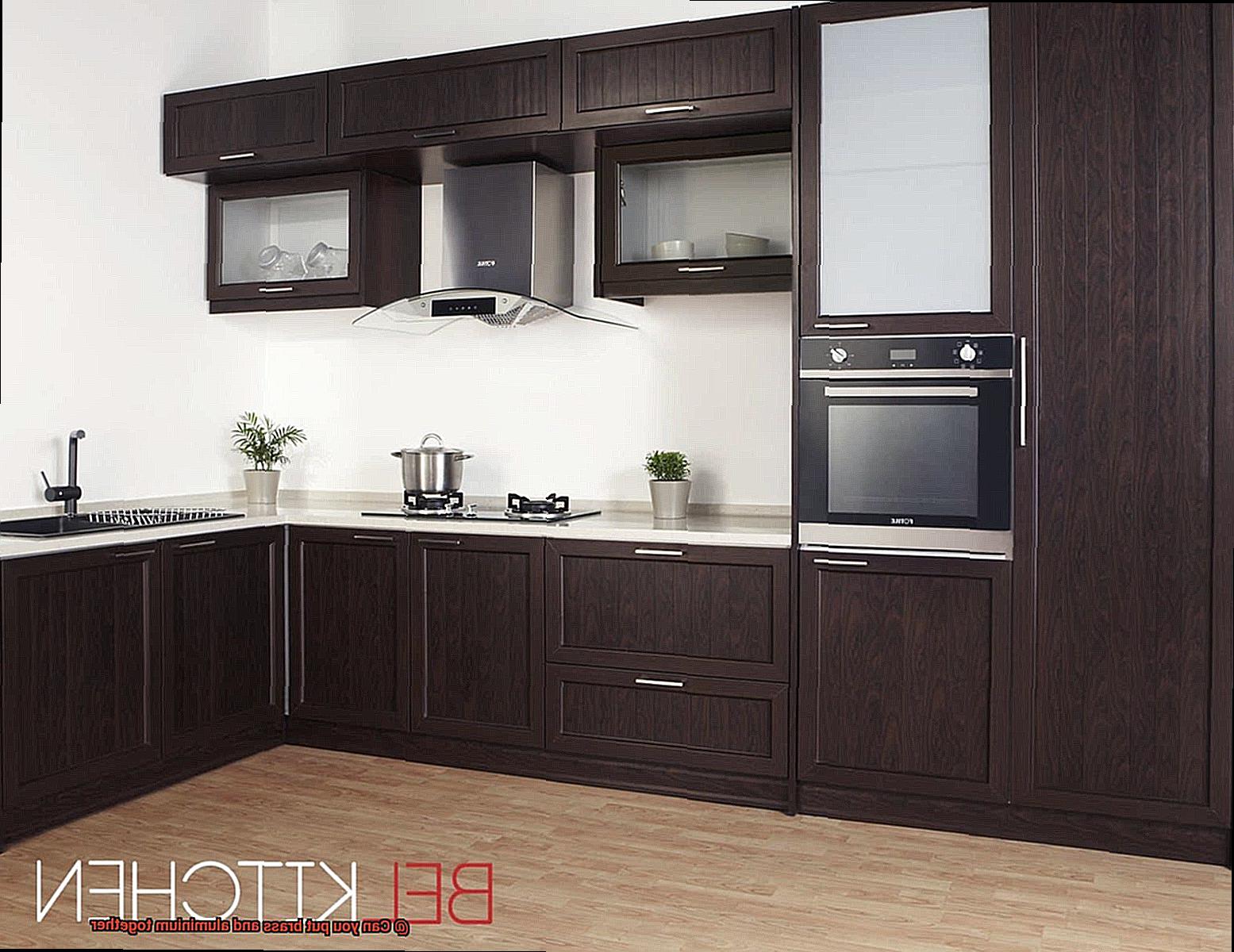
- Thorough cleaning and meticulous preparation are paramount for successful bonding.
- Brass is susceptible to oxidation or tarnishing, impeding effective adhesion.
- Prioritize meticulous surface cleaning, removal of oxidation layers, and employ primers or adhesion promoters for optimal results.
Alternative Methods of Joining Brass and Aluminum
If you’re intrigued by the challenge of bringing together these two contrasting materials, you’ve come to the right place. In this post, we’ll explore various techniques, with a particular focus on adhesive bonding. So, let’s dive in and uncover the secrets to a successful bond.
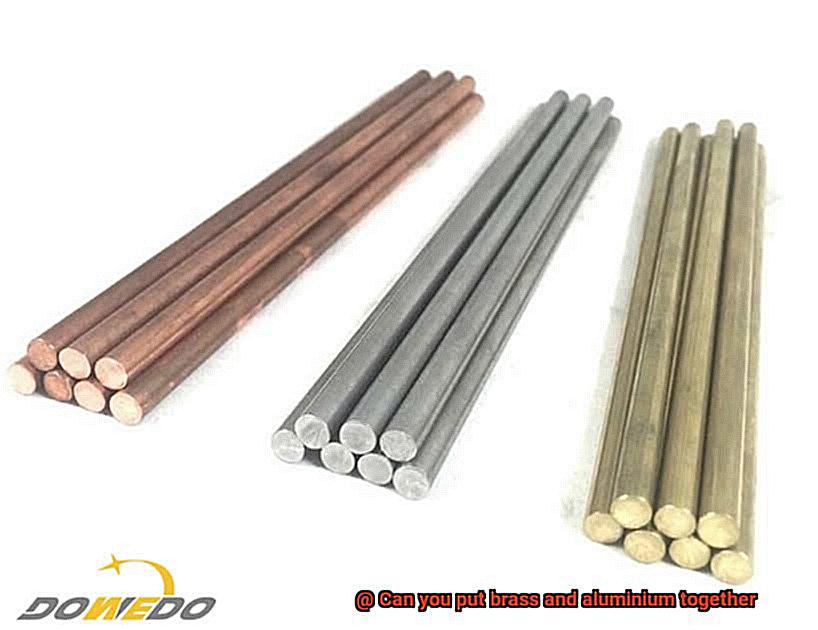
Welding:
Traditional welding can be challenging due to the different melting points of brass and aluminum. Specialized techniques like laser welding or friction stir welding allow for precise heat control, ensuring successful joint formation. These methods overcome the issue of disparate melting points and enable a strong bond between brass and aluminum.
Brazing:
Brazing offers an effective solution for joining dissimilar metals. By using a filler material with a lower melting point than the base metals, brazing allows the brass and aluminum to bond firmly. This method is widely used and ensures reliable connections. With proper heating and cooling cycles, the filler material melts and solidifies, forming a durable bond.
Adhesives:
Using adhesives specifically formulated for metal bonding provides an excellent alternative for joining brass and aluminum. Epoxy adhesives are commonly used and deliver exceptional strength when applied correctly. Proper surface preparation is crucial for adhesive bonding success. By roughening the surface, cleaning it thoroughly, and applying the adhesive evenly, a strong bond can be achieved.
Mechanical Fasteners:
Mechanical fasteners, such as screws, bolts, or rivets, provide a reliable and easily reversible connection between brass and aluminum. However, it’s crucial to consider galvanic corrosion potential and employ insulating materials or coatings to prevent accelerated corrosion. By using non-reactive materials or employing protective coatings, galvanic corrosion can be minimized.
Intermetallic Compounds:
In certain cases, intermetallic compounds can be formed between brass and aluminum, creating a solid bond. Precise control of temperature and time during the joining process is essential for successful formation of these compounds. By carefully controlling the heat input and maintaining the appropriate conditions, intermetallic compounds can be formed, resulting in a strong joint.
nxN_JNO_Fso” >
Conclusion
Yes, you can put brass and aluminium together, but it is not recommended. Mixing these two metals can lead to galvanic corrosion, a process where one metal corrodes in the presence of another metal due to an electrochemical reaction. This corrosion can weaken the materials and cause damage over time.
To avoid this issue, it is best to keep brass and aluminium separate or use a barrier between them, such as a non-conductive coating or insulating material. By taking these precautions, you can prevent galvanic corrosion and ensure the longevity of your materials.
Remember, while brass and aluminium may have their individual strengths and uses, combining them without proper protection can result in unwanted consequences. So, be mindful when considering using these metals together and take appropriate measures to preserve their integrity.
In conclusion, although it is technically possible to put brass and aluminium together, it is advisable to exercise caution and implement preventive measures against galvanic corrosion.






